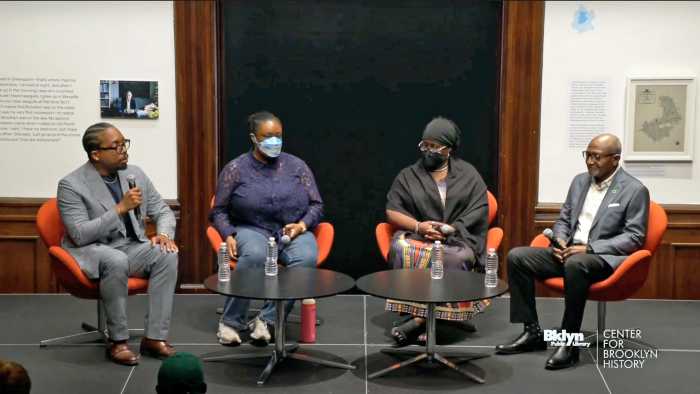Squeezing in four hours a day after his full time job and 20 hours on weekends, here is a man with a mission. Georges Vilson, also known as Mou Mous, a nickname that has stuck with Vilson since his Port-au-Prince childhood, was driven. His mission: to preserve traditional Haitian songs.
Vilson teaches music at James Madison High School in Brooklyn with a specialty in vocal music. A longtime engagement with music and his B.F.A. in music and Masters in Music Education prepared him for his career as a music educator that has spanned 20 years.
But, during this past last year, daily, after work, he’d return home in Ditmas Park to this passion-driven project.
Launched just last month, Vilson’s self-published Kandelab – named for a many-branched cactus in Haiti that serves as a “natural fence”–Volume I, notates 101 traditional songs, with lyrics.
The book has 26 folktales and fairytale songs, including the popular lullaby “Dodo”, and folktale songs “Tezen” (name of a fish) and “Brit Kolobrit” (about a bird going to see a sorcerer). Among the book’s 75 vodou songs is “Latibonito” –about the vodou god Atibon and the river, a song that has crossed-over as a popular music ballad.
Vilson has also produced an accompanying boxed set of 4 CDs. The first two CDs are piano renditions; he says they’re for slow music readers and those not familiar with traditional rhythms. CDs #3 and #4 are vocal performances by Vilson accompanied with drums and other traditional percussion. Both book and CD-set are available separately for purchase through Amazon.com.
How did this project start? “When I visited Haiti in 2011, I realized that young people, ages 20-30, only knew popular songs from abroad, those they heard on the radio, mainly from the U.S. and France. They were listening to reggae and merengue.”
This trip was his “eureka!” moment. “We need to preserve our traditional songs,” he vowed, thus plowing ahead with his mission.
Mous admits that as part of his life in music he had been thinking about these folk songs for a while. And, in spite of being raised in the Catholic Church, he been very curious about vodou music since his late teens and particularly, for the 10 years preceding this project, he had been learning in much greater depth about vodou songs.
Starting by writing down songs in his own memory repertoire, he then approached his mother and Haitian friends in Brooklyn. “Often a title or a first line would trigger the entire song,” he recalls.
During his initial research, he retrieved a recording from his files made 15 years before, when at home, he casually taped 18 songs sung by a friend who is a mambo– a female vodou priest. He met with other local vodou priests and mambos.
In this first round, he collected almost 30.
The music scribe went back to Haiti, visiting a vodou temple in the area of La Plaine, a district on the edge, just north of Port-au-Prince, where he recorded and collected more.
Remembering songs brought back memories. Finding new songs for this musician was invigorating. But, one of the biggest challenges for Vilson was learning a computer notation system. He bought a new computer dedicated to this project and ended up using the notation program Finale, which “helped a lot.”
Another challenge: he’d sometimes find the same melody with different lyrics. Vilson would notate the most well-known or common song. Vilson notes, “The 101 songs are transcribed in the conventional musical notation style so that all musicians are able to play along; lyrics in Kreyol written under the staff.”
Copies of the book and the CDs are at the arts boutique of Haiti Cultural Exchange (HCX) in Five Myles Gallery, 558 St. John’s Place where Mous will also speak in the fall as part of HCX’s An’n Pale series.
Mous is packing his bags for another research trip, leaving next week, when he will travel to Haiti’s lower Plateau Central– Mirebelais, Verrettes, and Port-a-Pitres to collect more folksongs. “I hope to come back with at least 10 from each area,” he says.
The actual notating and adding lyrics, while still collecting, took six months, an admitted “labor of love” with Volume II published in December.
Long-range plans: “I have 2-3,000 songs I want to publish,” the archivist says, expecting it will take 20 volumes to hold all the songs he plans to notate with lyrics.


























